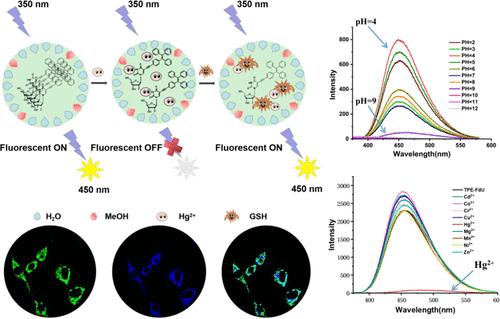当前位置:
X-MOL 学术
›
Anal. Chem.
›
论文详情
Our official English website, www.x-mol.net, welcomes your
feedback! (Note: you will need to create a separate account there.)
Enhancing or Quenching of a Mitochondria-Targeted AIEgens-Floxuridine Sensor by the Regulation of pH-Dependent Self-assembly, Efficient Recognition of Hg2+, and Stimulated Response of GSH
Analytical Chemistry ( IF 6.7 ) Pub Date : 2023-12-13 , DOI: 10.1021/acs.analchem.3c04415 Yating Zeng 1 , Ziyan Wang 1 , Linyu Zeng 1 , Hai Xiong 1
Analytical Chemistry ( IF 6.7 ) Pub Date : 2023-12-13 , DOI: 10.1021/acs.analchem.3c04415 Yating Zeng 1 , Ziyan Wang 1 , Linyu Zeng 1 , Hai Xiong 1
Affiliation

|
Biocompatible fluorescent probes have emerged as essential tools in life sciences for visualizing subcellular structures and detecting specific analytes. Herein, we report the synthesis and characterization of a novel fluorescent probe (TPE-FdU), incorporated with hydrophilic 2′-fluoro-substituted deoxyuridine and hydrophobic ethynyl tetraphenylethene moieties, which possessed typical aggregation-induced emission (AIE) behavior. In comparison to the TPE-FdU (pKa 7.68) treated in neutral conditions, it performed well at pH 4, exhibiting an enhanced 450 nm emission signal of approximately four times stronger. As the pH value was increased to 10, the fluorescence intensity was completely quenched. The TEM images of TPE-FdU in an acidic environment (nanospherical morphology, AIE enhance, pH = 4) and in a basic environment (microrods, fluorescence quenching, pH = 9) revealed that it was a pH-dependent self-assembled probe, which was also illustrated by the interpretation of the NMR spectrum. Furthermore, the TPE-FdU probe exhibited a specific response to trace Hg2+ ions. Interestingly, the quenched fluorescence of the TPE-FdU probe caused by Hg2+ can be recovered by the addition of GSH due to the formation of the Hg–S bond being released away. MTT assay and CLSM images demonstrated that TPE-FdU was nontoxic and selectively visualized in the intracellular mitochondria. These results contributed to the development of advanced fluorescent probes with diverse applications in cell imaging, environment protection, and biomedical research.
中文翻译:

通过调节 pH 依赖性自组装、Hg2+ 的有效识别和 GSH 的刺激响应来增强或猝灭线粒体靶向 AIEgens-Floxuridine 传感器
生物相容性荧光探针已成为生命科学中用于可视化亚细胞结构和检测特定分析物的重要工具。在此,我们报道了一种新型荧光探针(TPE-FdU)的合成和表征,该探针结合了亲水性2'-氟取代的脱氧尿苷和疏水性乙炔基四苯乙烯部分,具有典型的聚集诱导发射(AIE)行为。与中性条件下处理的 TPE-FdU(p K a 7.68)相比,它在 pH 4 下表现良好,表现出增强的 450 nm 发射信号,强度约为四倍。当pH值增加到10时,荧光强度完全猝灭。 TPE-FdU在酸性环境(纳米球形貌,AIE增强,pH = 4)和碱性环境(微棒,荧光猝灭,pH = 9)中的TEM图像表明它是一种pH依赖性自组装探针, NMR 谱的解释也说明了这一点。此外,TPE-FdU 探针对痕量 Hg 2+离子表现出特异性响应。有趣的是,由于 Hg-S 键的形成被释放,TPE-FdU 探针由 Hg 2+引起的荧光猝灭可以通过添加 GSH 来恢复。 MTT 测定和 CLSM 图像表明 TPE-FdU 无毒,并且在细胞内线粒体中选择性可视化。这些结果有助于开发在细胞成像、环境保护和生物医学研究等领域具有多种应用的先进荧光探针。
更新日期:2023-12-13
中文翻译:

通过调节 pH 依赖性自组装、Hg2+ 的有效识别和 GSH 的刺激响应来增强或猝灭线粒体靶向 AIEgens-Floxuridine 传感器
生物相容性荧光探针已成为生命科学中用于可视化亚细胞结构和检测特定分析物的重要工具。在此,我们报道了一种新型荧光探针(TPE-FdU)的合成和表征,该探针结合了亲水性2'-氟取代的脱氧尿苷和疏水性乙炔基四苯乙烯部分,具有典型的聚集诱导发射(AIE)行为。与中性条件下处理的 TPE-FdU(p K a 7.68)相比,它在 pH 4 下表现良好,表现出增强的 450 nm 发射信号,强度约为四倍。当pH值增加到10时,荧光强度完全猝灭。 TPE-FdU在酸性环境(纳米球形貌,AIE增强,pH = 4)和碱性环境(微棒,荧光猝灭,pH = 9)中的TEM图像表明它是一种pH依赖性自组装探针, NMR 谱的解释也说明了这一点。此外,TPE-FdU 探针对痕量 Hg 2+离子表现出特异性响应。有趣的是,由于 Hg-S 键的形成被释放,TPE-FdU 探针由 Hg 2+引起的荧光猝灭可以通过添加 GSH 来恢复。 MTT 测定和 CLSM 图像表明 TPE-FdU 无毒,并且在细胞内线粒体中选择性可视化。这些结果有助于开发在细胞成像、环境保护和生物医学研究等领域具有多种应用的先进荧光探针。































 京公网安备 11010802027423号
京公网安备 11010802027423号